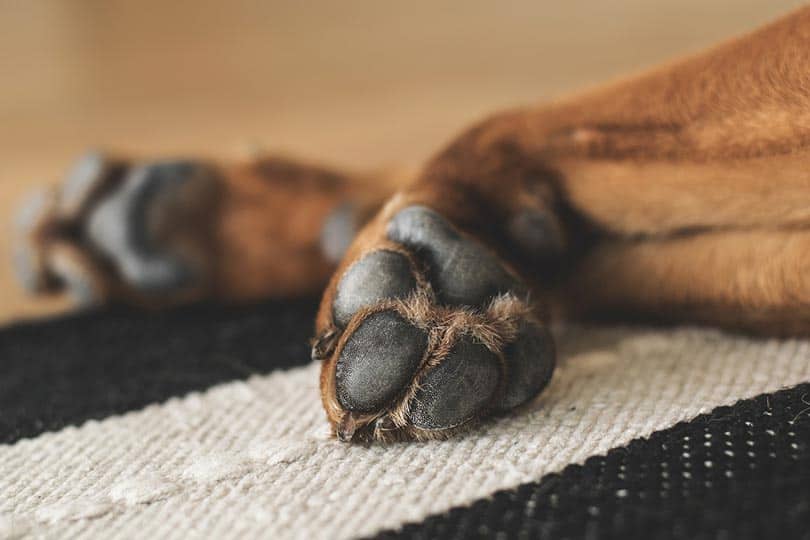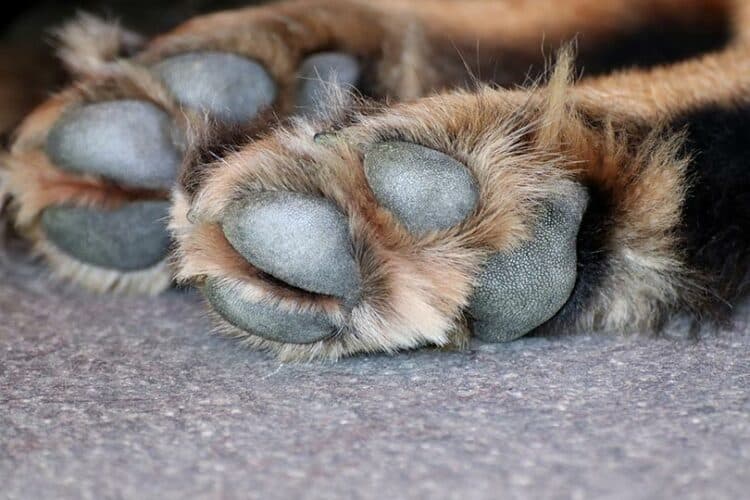As pet owners, we’re obsessed with our dogs’ feet and how cute they are. Next time you’re lavishing your dog’s paws with the love they deserve, you might want to observe their texture. It’s common for the paw pads to be rough or cracked, and it’s important to take care of them when you notice this.
Paw pads are made up of a layer of pigmented skin covering fatty tissue. They protect your dog’s feet, help them stay balanced, and provide extra traction and shock absorption. They also act as indicators of your pup’s overall health, so keeping an eye on their condition and caring for them is an essential part of canine maintenance.
If you notice your dog’s paw pads are especially rough, you can read on to learn more about the causes of the condition.
Top 4 Reasons Dog’s Paws Are Rough
1. Hot Weather
Summer is a typical time for your dog’s paws to feel rough, especially if you walk them on an asphalt or concrete surface. Pavement absorbs heat and can become difficult to walk on after a long, sunny day.
If your dog has trouble on the hot pavement or you notice a lot of roughness and cracking on its paws, you might try walking it early in the morning, before the pavement has time to heat up, or later in the day, when it’s had a chance to cool down.
Also, remember that sand and saltwater can get very hot, so if your dog spends a lot of time at the beach, that could also be a contributing factor.
2. Cold Weather
On the flip side, winter can be an equally rough season for paw pads. Walking in the snow or on an icy surface can harm your dog’s paws.
However, the primary culprit that causes rough paws, is the heat you use to keep your house warm. Turning on your heat creates dry air, which can cause your dog’s skin to become dry and crackly, especially on its paws and nose.
3. Chemical Exposure
Chemicals and irritants are all around us. Since your dog is barefoot all day, it’s likely that it will be exposed to irritating chemicals at one point or another.
Fertilizers and pesticides are common culprits in the warmer months, especially in yards and gardens. Salt on the roads and other de-icing agents contain ingredients that might bother your pup’s paws during the winter. Plus, you may use chemicals year-round in your own home, like cleaners for your kitchen and bathroom.
Your dog may walk across surfaces or through areas treated with these chemicals, which can irritate its paws and cause them to become rough or cracked.
4. Allergies or Underlying Medical Issues
Just like humans, dogs are susceptible to allergies, both environmental and from food. Allergies can cause rough, dry, or itchy paws, which may make your pup lick its feet, further drying them out and worsening the issue.
A medical condition can also be the cause of rough paws. Hyperkeratosis occurs when a dog’s body produces too much keratin. Keratin is a protein that protects underlying layers of skin, most commonly seen in your dog’s nose or paw pads. It manifests as a raised crust of skin or a hairy growth that resembles tentacles.
Vets don’t know what causes hyperkeratosis, but it’s usually a lifelong, benign condition that has few effects on your dog’s health. However, it can impact the way it walks or how comfortable it feels on its feet, so topical treatments can be worth looking into.

Caring for Rough Paws
It may seem like you have little control over the factors that can roughen your dog’s paw pads. The good news is that there are ways you can ameliorate the roughness and make your pup more comfortable.
A few tips for taking care of your dog’s paw pads include:
- Avoid walking it on hot pavement
- Keep the nails and fur on its feet trimmed
- Have your dog wear booties or paw wax in the snow
- Clean its paws with soap and water if you suspect chemical exposure
- Moisturize with dog-safe lotions, coconut oil, or petroleum jelly when necessary
Wrapping Up
Your dog will thank you for keeping an eye on its paw pads and taking care of them so that it can walk and run without discomfort. Rough or cracked paw pads are not necessarily a cause for alarm, but it is crucial to understand the reasons behind it and know how to improve the condition to keep your pup happy and active.
Featured Image Credit: Pixabay














